We learn from experienced summer residents how to plant tomatoes correctly: an analysis of the nuances and a step-by-step description of the process
Timely and competent removal of tomato shoots will help to obtain strong plants and a rich harvest. When pruning shoots, take into account the tallness of the variety, the peculiarities of stem development and planting conditions. We offer a step-by-step technology with photos on how to properly plant different types of tomatoes - from tall to standard varieties.
What is stepsoning and what does a stepson look like?
Pinching is the removal of lateral shoots that appear in the axils of the leaves on the main stem of the plant. Beginner gardeners sometimes confuse stepsons with leaves or flower clusters.
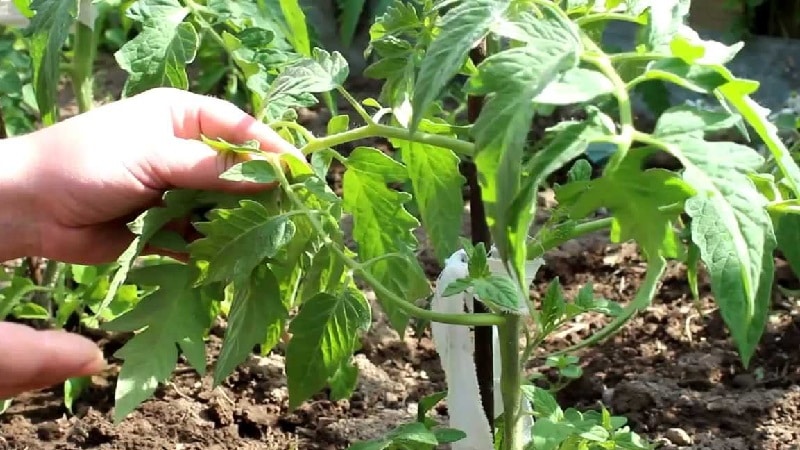
How to distinguish a stepson from a fruit brush and leaf
To avoid accidentally tearing off a brush, carefully examine the plant:
- the stepson always grows from the axil - the recessed area between the leaf and the main stem of the tomato;
- the flower cluster is formed on the stem; there are not even leaf rudiments on it - only small forming buds are visible.
Some stepchildren also have buds. In this case, wait a couple of days until the shoot grows, so as not to confuse it with a fruit brush.
To distinguish the lateral shoot from the leaf, look closely at the lash. The stepson always grows from the axil of a large, developed leaf; over time, it develops several small leaves of its own.
To stepchild or not
To find out whether you need to stepchild a certain tomato variety, study the information about it on the bag of seeds or find a description of the variety on the Internet.
Is it possible and what will happen if you don’t plant tomatoes?
Pinching is carried out so that the plant devotes all its energy to the formation of fruits, and does not spend it on feeding additional shoots.
Attention! If the stepsons are not removed in a timely manner, the green mass of the bush will grow, and due to poor ventilation the risk of disease will increase. The plant forms few ovaries on the cluster, and the formed fruits will be small.
Taking this into account, breeders have developed many varieties that do not require pinching.
What varieties can you not plant?
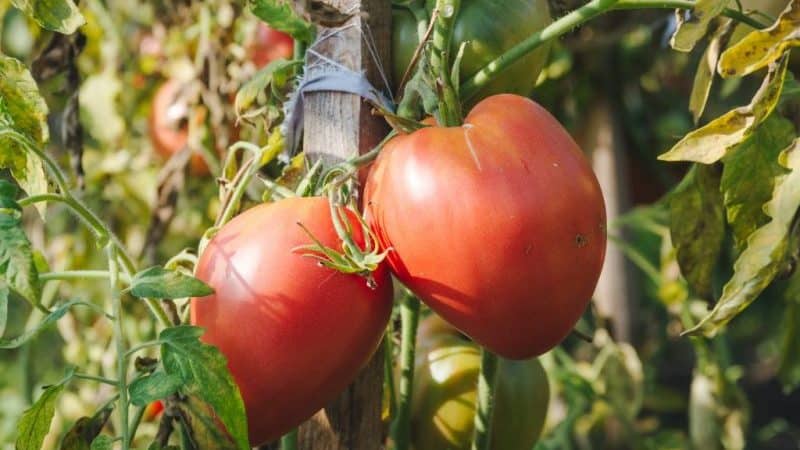
Short ones don't take stepson determinate tomatoes of standard varieties. Their growth is limited, and the side shoots grow weakly. Therefore, the plant has enough strength to provide nutrition to additional stems and the plants formed on them. ovaries.
In areas with a warm climate in open ground, thickening does not harm plants, but in regions with low summer temperatures and high humidity it contributes to the appearance of bacterial diseases, late blight. In this case, it is recommended to plant undersized tomatoes.
How to properly cut off stepsons
Inept or untimely removal of stepchildren leads to diseases plant, stops its development and reduces productivity.
Basic Rules
To get a healthy, optimally developing bush, adhere to the following rules of pinching:
- The procedure is carried out regularly, at least once a week. With such frequency, it will be possible to promptly notice the emerging processes in the sinuses.
- Do not water the soil before planting.
- Shoots 3–5 cm long are removed. When shoots longer than 5 cm are cut out, the plant experiences stress and the wounds heal worse.
- Small stepsons break off easily and with a crunch. If they have outgrown the first leaf formation phase, use a sharp tool for cutting.
- All instruments are pre-disinfected with a solution of potassium permanganate or chlorhexidine. This will prevent the transmission of diseases from one bush to another.
- A small “stump” is left in the sinus so that a new additional shoot does not form in place of the old one.
The best time to remove side shoots is morning. During these hours, the movement of juices and nutrients is less active than during the day. The shoots are more fragile and easier to break off. During the day, the wounds will have time to heal, and in the evening the plants are watered.
Stepping: technology and features
When forming bushes, the type of growth of tomatoes, growing conditions and methods of pinching are taken into account.
In the open ground
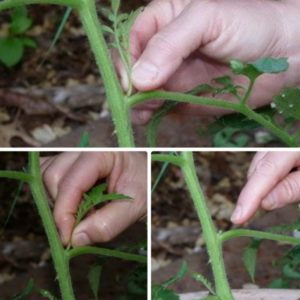
When growing tomatoes in open ground, additional shoots are removed, adhering to the basic rules of pinching. Do not carry out the procedure during the rainy season - the stems filled with moisture become more flexible and dense, and break off easily. There is a high risk of developing diseases. It is better to wait for dry weather and remove overgrown shoots than to lose the harvest due to disease.
For short-trunked standard varieties in open ground, it is not necessary to trim the stepsons.
In the greenhouse
In greenhouses Traditionally, tall and medium-sized varieties with a high intensity of formation of stepsons are grown. When treated once a week, the side shoots outgrow. They are broken off at least 2 times a week, preventing the plants from becoming dense.
Advice! On the eve of planting, do not water the soil in the greenhouse to ensure dry air. After pruning in sunny weather, provide good ventilation.
Gardeners argue about which method of removing side shoots in a greenhouse is more rational to use - pruning or breaking them out of the axil. The choice of method depends on the specific growing conditions. If the plantings are thickened, there is high air humidity in the greenhouse and there is an increased level of infection, pruning will lead to the appearance of gray rot on the “stumps” left in the sinuses. In this case, the shoots are broken off.
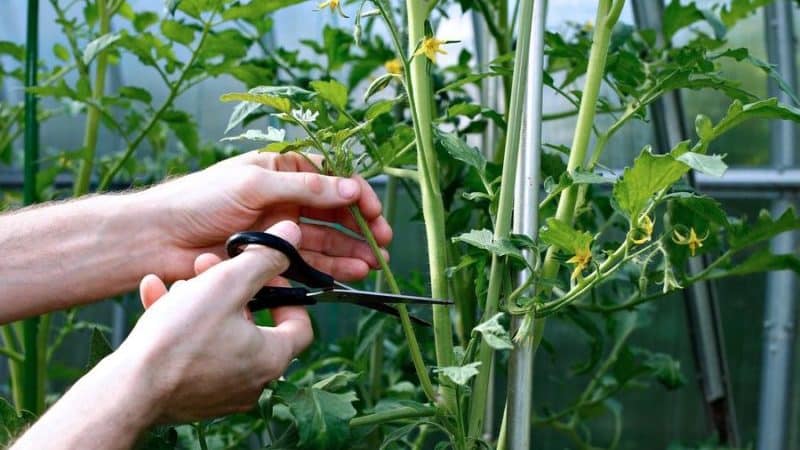
How the procedure changes depending on the type of tomato
To understand how to properly plant a plant, it is important to find out in advance what type it is, depending on its growth characteristics. Before purchasing and growing, it is advisable to study the varietal description of the tomato on the website or in the information materials of the nursery where the seedlings were purchased.
There are 2 main types of tomatoes:
- indeterminate varieties - characterized by unlimited stem growth;
- determinant - grow to a height determined by the varietal characteristics, and then mature.
Determinate are divided into subtypes:
- semi-determinate - medium-sized;
- superdeterminant - small-growing, standard.
This knowledge will help in the future not to make mistakes when removing stepsons and forming a bush.
Stepping scheme for indeterminate and determinate varieties
Indeterminate varieties very actively produce additional shoots, and clusters with ovaries are formed only after 3 leaves. Therefore, keeping such tomatoes in one stem and timely pruning of the stepsons are prerequisites for obtaining a good harvest in the future.
To form into 1 stem, as soon as the plant begins to produce additional shoots, they are immediately removed. The main and only stem is tied with twine, like a vine, to a trellis.
Determinant tomatoes are formed according to patterns of 2 or 3 stems. The growth of the main shoot of these plants is limited. At any moment it can stop developing, even if the end of summer is still far away. To prolong growth and get a good harvest from determinate types of tomatoes, additional stems are left on the bush.
Scheme with 2 stems: On the main stem, the strongest and healthiest shoot is selected and grown as an equivalent second stem. They tie it up and pin it in the same way as the main one.
3 stem pattern: In addition to the main shoot, 2 more strong shoots are left on the lower part of the plant. This option is the most common. If a powerful stepson is at the top, it is allowed to grow it as a third stem.
Semi-determinate type of tomatoes
Semi-determinate tomatoes grow up to 150–180 cm. The main stem of such a plant always ends up - it ends its growth, forming a peduncle at the end. The height of the main shoot and the number of ovaries on it depend on the varietal characteristics.
If you grow such a tomato with 1 stem, the yield will be extremely low. Therefore, 2 additional well-developed stepsons are left on the main stem; 3-4 brushes will grow on them. To assess how strong the shoot will be, wait until it grows to 5 cm. If the shoot turns out to be weak and throws out few inflorescences, it is pinched and the formation of a new one begins.
Growing standard tomatoes
Standard varieties and hybrids are distinguished by strong, dense stems and leaves. Most often these are compact, low-growing determinate tomatoes up to 70–90 cm in height. They do not actively produce shoots, so they do not require pinching.
Reference. To obtain an earlier and more robust harvest with large fruits from a low-growing standard tomato, leave 2-3 stepsons on the stem and no more than 6-8 inflorescences.
Experienced gardeners prefer to plant even such varieties in order to increase the yield and weight of the fruit. Otherwise, the bushes will be too thick, which will interfere with good ventilation and increase the risk of developing late blight. For optimal growth and yield, leave 3-4 stems per plant.
Growing large-fruited tomatoes
When planting large-fruited tomatoes, there are some nuances. The stepsons in the leaf axil are removed directly under the developing raceme, otherwise it will be difficult to achieve the declared varietal characteristics in terms of fruit weight. The fact is that tomato leaves accumulate nutrients and gradually release them to the growing and filling fruits. The stepson under the brush will take all the minerals from the leaf for its own development.
How to plant tall varieties
Tall tomatoes with unlimited growth most often follow the 1-stem pattern, cutting off absolutely all emerging shoots. This way, plants do not lose strength to develop additional shoots and leaves, but redirect them to the formation of ovaries and fruits. Inflorescences are formed through 3 leaves; 6–8 clusters are formed on one stem, depending on the variety.
In conditions when the height of the greenhouse is small, and the potential for the formation of the number of clusters in the variety has not been exhausted, one of the stepsons is left to maintain the second stem. To do this, choose the strongest shoot under the brush or root shoot.
Is it necessary to remove the first stepson?
Immediately after the formation of the flower cluster, stepsons begin to grow in the axils of the leaves. They are removed if the tomato is grown in 1 stem. If you plan to have a two- or three-stem scheme for growing tomatoes, the stepsons are allowed to grow to 5–7 cm and the strongest one is selected. Most often this is the first shoot under the flower brush. A powerful additional stem is obtained from it.
If the first subcarpal shoot is removed by mistake, a shoot above the flower raceme is used for an additional stem. In this case, the harvest will be later, since the ovaries on the cluster will receive nutrition from the root first.
How long to remove shoots on tomatoes
Stepchildren appear on tomatoes from 2 weeks after planting. Their formation continues throughout the growing season. Sometimes additional processes begin to re-grow in those sinuses where they were previously removed. This is a varietal feature of tomatoes. Therefore, additional shoots are removed until the final harvest.
When and how to pinch tomatoes
Determinate tomatoes finish growing on their own, producing a cluster of flowers on the stem. Tall indets grow indefinitely, so gardeners carry out pinching, or topping, of the stem.
The top of the stem is broken off or cut so that 2 leaves remain after the flower brush. In the future they will nourish the ovaries.
Reference. Stem growth is limited at the end of the growing season so that the fruits have time to fill and ripen. Depending on the region, this period falls on July–August.
The top is pinched just before the bush reaches the ceiling of the greenhouse. The growing point on the side shoots is removed to redirect the flow of nutrients to the development of another stem and the tomatoes ripen better.
Basic recommendations
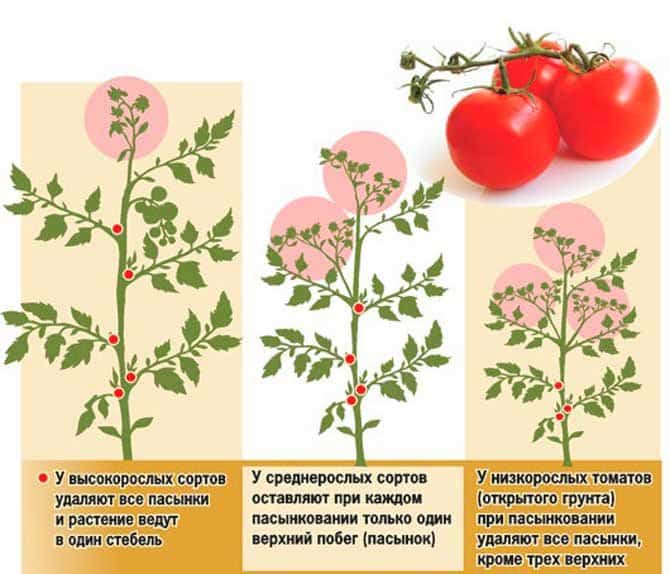
Experienced gardeners have already learned all the nuances of growing tomatoes from their own or others’ mistakes. We list their main recommendations:
- Before removing the stepsons, take a close look at them: do not confuse the flower cluster with a side shoot.
- Remove stepchildren regularly and in a timely manner, do not allow their size to exceed 5 cm.
- Carefully study the description of the variety to form the bush correctly. Depending on whether the plant belongs to the indeterminate or determinate type, as well as the place of cultivation (in open ground or greenhouse), choose a pinching scheme.
- Standard varieties that do not require pinching according to the recommendations of breeders, grow in small areas with 3-4 stems so as not to create thickening of the bushes, the appearance of rot and late blight.
- Pinch the side stems and tops of indeterminate tomatoes in a timely manner.
Conclusion
To carry out pinching correctly, the type of growth of tomatoes is determined: indeterminate ones are formed into 1 stem, determinate ones - into 2 and 3. For medium-sized varieties, 2 developed lateral shoots are left, some gardeners advise forming standard plants into 3-4 stems. Tomatoes are planted regularly until the end of the fruiting season. Do not allow plantings to become dense.
I am a beginner gardener, this article helped me a lot, thank you!
Great! We are sure that everything will work out for you :)